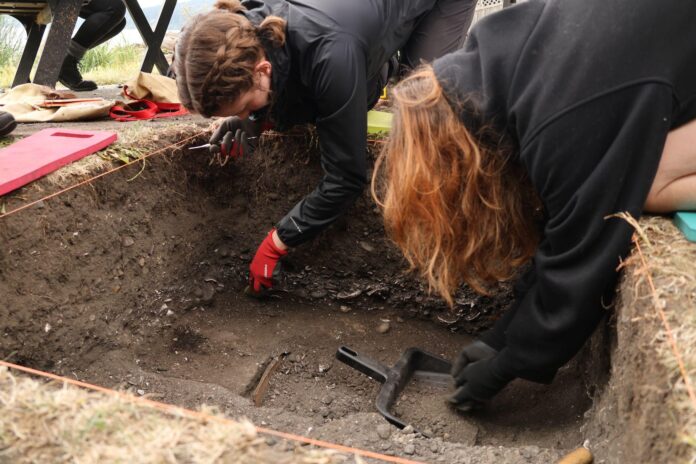Excavations by students from Canada’s University of Victoria in a suburban waterfront park, on the traditional homeland of the W̱SÁNEĆ nation, have revealed a rare 1,000-year-old fish trap and the remains of the ancestral village of ȾEL¸IȽĆE (pronounced Tel-eech). The W̱SÁNEĆ people say the site, once home to around 250 people and now in the midst of expensive waterfront real estate, is surrounded by burial sites as well as fishing grounds.
“We found a giant rock wall buried in the sand and sediment,” explains project leader Brian Thom, an associate professor in the university’s anthropology department. “When we pulled it all away we discovered it formed a huge ‘U’ shape in the bay. It functioned as a fish trap—when the tide receded, it would catch smelt and herring.”
Thom’s dig included Native elders and community members as well as students, and was funded by a federal job training grant. He says this kind of fish trap is novel in an urban context. “We generally see this in more remote areas of the coast—like Haida Gwaii—but for the most part these features haven’t survived the footprint of urbanisation.”
The site is in Cordova Bay, a wealthy suburb of Victoria, British Columbia, and has barely survived 150 years of “settler colonialism”, Thom adds. The site was documented in 18th- century Spanish naval maps indicating two longhouses at ȾEL¸IȽĆE. It was at the centre of the South Saanich Treaty in 1852, which promised to set aside the village site and enclosed fields for the nation to use. The village never was set aside, save for the waterfront sliver now known as Agate Park, where the dig has taken place.
Thom surmises that smallpox wiped out much of the local native population and by the time Emily Carr painted her famous scene of Cordova Bay, there was little sign of First Nations life.

A unilaterally barbed serrated bone harpoon point from 2023 archaeological excavations at the ȾEL ̧IȽĆE village site Photo by Brian Thom, courtesy of University of Victoria
The recent dig that took place throughout the month of July follows one in 2008, when the remains of 14 bodies dating back 1,000 years were uncovered during excavations to build a house in the area. That dig turned up 350 artefacts, including a rare barbed serrated bone harpoon point, that are now stored at the Royal British Columbia Museum in Victoria.
According to Thom, the recent dig also uncovered a wide range of domestic as well as hunting and fishing tools, a fire hearth and remains of food. When he was approached by the local First Nations communities to have his field school further investigate the site, the goal was also “to create a provocation in the community about colonial displacement of a people and a village”. The dig, he says, comprised largely of indigenous youth and elders, was “an initiation of a conversation to bring the W̱SÁNEĆ back to their land”.
He says the most powerful moment of the whole dig was when a local First Nations day-care centre and language immersion camp came to visit the site. “The children went down to the ocean, turned around and sang to their ancestors in their original language and asked us to stand on the banks and receive the songs of their ancestors.”
Meanwhile, Thom’s students continue to pursue research informed by discoveries and experiences at the site. Graduate students, including a Native elder doing her PhD, are looking at subjects ranging from connecting ancient fishing practices with contemporary treaty rights to looking at “disaster archaeology” at the site. The latter involves studying the history of burial desecration and exhumation, as evidenced by newspaper reports of homeowners finding skulls in their backyards, as well as the bulldozing of the site to build new properties.

Tsawout youth and University of Victoria anthropology students excavating at ȾEL ̧IȽĆE the ancient Cordova Bay village site Photo by Brian Thom, courtesy of University of Victoria.
Though heritage protection is a major priority for First Nations in British Columbia, which is largely unceded territory, there is little enforcement of existing legislation, says Thom, with only a single conviction in the history of the province. The prevailing practice of “dig first, ask questions later”, he says, needs to be changed to align with Canada’s obligations under the United Nations charter.
The fate of the Cordova Bay site appears to be a crucible for the province’s relationship to First Nations’ heritage. “If we get this right, it could become a model for other sites,” Thom says.
A proposal to create an installation to commemorate the site, such as a large totem pole or other traditional work by a local Native artist, has been embraced by the local homeowners’ association, which has pledged C$10,000 ($7,500) toward the estimated C$250,000 ($187,000) budget for the project. About 10% of the cost of the dig was also raised through community fund-raising.
The dig ended with a special procession with rattles and songs to “clear a path for the spirits to leave”, Thom says. For Elder Mavis Underwood, a PhD candidate writing a thesis around heritage education of future generations who lives on the nearby W̱SÁNEĆ reserve, the dig was about “reconnection with homeland and finding that place of belonging”.
In addition to being a “huge educational opportunity”, Underwood says, the dig uncovered “artefacts that reinforced the right to fish” including sharp bone and antler fishhooks on wooden frames and slate knives used for cleaning fish. “When we uncovered the fish wall that was so important,” she says. “It was like the ancestors were waiting for us to tell us that ‘this was how we got food.”

























